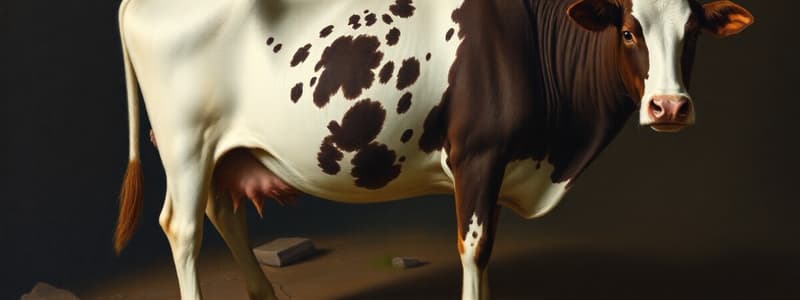Podcast
Questions and Answers
In dairy cows, a common metabolic disorder, __________, often manifests in early lactation due to energy demands exceeding intake, leading to symptoms like decreased appetite and reduced milk production.
In dairy cows, a common metabolic disorder, __________, often manifests in early lactation due to energy demands exceeding intake, leading to symptoms like decreased appetite and reduced milk production.
ketosis
__________ in livestock arises from imbalances in essential nutrients, disrupting normal metabolic functions, indicating the critical role of balanced nutrition.
__________ in livestock arises from imbalances in essential nutrients, disrupting normal metabolic functions, indicating the critical role of balanced nutrition.
Nutritional metabolic disorders
The key to avoiding mineral metabolism disorders such as grass tetany, is achieved by supplementing __________ in the diet of grazing livestock, preventing muscle spasms and staggering.
The key to avoiding mineral metabolism disorders such as grass tetany, is achieved by supplementing __________ in the diet of grazing livestock, preventing muscle spasms and staggering.
magnesium
Sudden drops in these mineral levels around calving often lead to __________ in dairy cows, characterized by muscle weakness and recumbency, highlighting the need for careful mineral balance.
Sudden drops in these mineral levels around calving often lead to __________ in dairy cows, characterized by muscle weakness and recumbency, highlighting the need for careful mineral balance.
To maintain rumen health and prevent acidosis, it's crucial to ensure __________ fiber in the diet, which also stimulates saliva production to buffer rumen acids.
To maintain rumen health and prevent acidosis, it's crucial to ensure __________ fiber in the diet, which also stimulates saliva production to buffer rumen acids.
Ensuring consistent access to __________ is vital, as its quality directly influences animal health and nutrient absorption, often overlooked in nutritional management.
Ensuring consistent access to __________ is vital, as its quality directly influences animal health and nutrient absorption, often overlooked in nutritional management.
Implementing __________ practices for feed is crucial to prevent spoilage and nutrient loss, directly impacting the quality of nutrition animals receive.
Implementing __________ practices for feed is crucial to prevent spoilage and nutrient loss, directly impacting the quality of nutrition animals receive.
Early detection of metabolic disorders relies on monitoring for subtle signs like decreased appetite and weight loss, prompting the need for __________ to improve outcome chances.
Early detection of metabolic disorders relies on monitoring for subtle signs like decreased appetite and weight loss, prompting the need for __________ to improve outcome chances.
Copper levels require careful attention in sheep and goats to prevent __________, while also ensuring sufficient energy intake during late pregnancy to avoid pregnancy toxemia.
Copper levels require careful attention in sheep and goats to prevent __________, while also ensuring sufficient energy intake during late pregnancy to avoid pregnancy toxemia.
For swine, the emphasis should be on formulating diets based on __________ requirements to enhance growth and feed efficiency, coupled with vitamin and mineral supplements as necessary.
For swine, the emphasis should be on formulating diets based on __________ requirements to enhance growth and feed efficiency, coupled with vitamin and mineral supplements as necessary.
Flashcards
Ketosis
Ketosis
Occurs in early lactation when energy demand exceeds intake, leading to fat mobilization and ketone production.
Pregnancy Toxemia
Pregnancy Toxemia
Similar to ketosis but occurs in ewes and does during late pregnancy due to high energy demands.
Fatty Liver Syndrome
Fatty Liver Syndrome
Excessive fat accumulation in the liver, impairing function, often linked to high-energy diets and insulin resistance.
Milk Fever
Milk Fever
Signup and view all the flashcards
Grass Tetany (Hypomagnesemia)
Grass Tetany (Hypomagnesemia)
Signup and view all the flashcards
White Muscle Disease
White Muscle Disease
Signup and view all the flashcards
Acidosis
Acidosis
Signup and view all the flashcards
Regular Feed Analysis
Regular Feed Analysis
Signup and view all the flashcards
Role of Fiber
Role of Fiber
Signup and view all the flashcards
Factors Influencing Nutrient Requirements
Factors Influencing Nutrient Requirements
Signup and view all the flashcards
Study Notes
- Nutritional metabolic disorders in livestock arise from imbalances or deficiencies in essential nutrients, which disrupt normal metabolic functions
- Effective nutritional management aims to prevent these disorders by providing a balanced diet tailored to the animal's physiological state and production demands
Energy Metabolism Disorders
- Ketosis occurs when energy demand exceeds energy intake, leading to excessive fat mobilization and ketone body production
- In dairy cows, ketosis typically occurs in early lactation
- Symptoms include decreased appetite, reduced milk production, weight loss, and acetone odor in breath
- Pregnancy toxemia is similar to ketosis but occurs in late pregnancy, mainly in ewes and does
- Fatty liver syndrome involves excessive fat accumulation in the liver, impairing its function, often linked to high-energy diets and insulin resistance
- Prevention involves avoiding overfeeding during late pregnancy and ensuring adequate energy intake during early lactation or periods of high energy demand
Mineral Metabolism Disorders
- Milk fever (parturient paresis) results from a sudden drop in blood calcium levels around calving in dairy cows
- Symptoms include muscle weakness, tremors, and recumbency
- Grass tetany (hypomagnesemia) is caused by low magnesium levels in blood, typically occurring in grazing livestock on lush pastures
- Symptoms include muscle spasms, staggering, and convulsions
- Prevention involves supplementing magnesium in the diet or using magnesium-rich fertilizers on pastures
- Calcium and phosphorus imbalances can lead to skeletal problems such as rickets in young animals and osteomalacia in adults
- White muscle disease is caused by selenium and/or vitamin E deficiency, leading to muscle degeneration in young animals
- Symptoms include stiffness, lameness, and respiratory distress
- Prevention involves supplementing selenium and vitamin E in the diet
Vitamin Metabolism Disorders
- Vitamin A deficiency can cause impaired vision, reproductive problems, and increased susceptibility to infections
- Vitamin D deficiency leads to impaired calcium absorption and bone mineralization, resulting in rickets or osteomalacia
- Vitamin E deficiency can cause white muscle disease and reproductive problems
- B-vitamin deficiencies can affect energy metabolism, nerve function, and red blood cell production
Acid-Base Balance Disorders
- Acidosis occurs when the rumen pH drops too low, often due to excessive consumption of rapidly fermentable carbohydrates
- Symptoms include decreased appetite, diarrhea, and laminitis
- Alkalosis occurs when the rumen pH is too high, often due to excessive protein intake or inadequate fiber
- Symptoms include decreased appetite and digestive upset
- Prevention involves balancing the diet with adequate fiber and avoiding sudden changes in feed
Nutritional Management Strategies
- Regular feed analysis to determine nutrient content and adjust diets accordingly
- Providing a balanced diet that meets the animal's specific nutrient requirements based on age, physiological state, and production level
- Ensuring access to clean and fresh water at all times
- Monitoring body condition score to assess energy reserves and adjust feeding accordingly
- Implementing proper feed storage and handling practices to prevent spoilage and nutrient loss
- Supplementing vitamins and minerals as needed, especially during periods of high demand or when deficiencies are identified
- Avoiding sudden changes in diet to prevent digestive upset
- Providing adequate fiber to maintain rumen health and prevent acidosis
- Monitoring animal health and addressing any signs of metabolic disorders promptly
- Consulting with a veterinarian or nutritionist to develop a customized feeding plan
Specific Nutritional Considerations
- Dairy Cows: Focus on energy balance during early lactation to prevent ketosis, and adequate calcium and phosphorus levels to prevent milk fever
- Beef Cattle: Ensure adequate energy and protein intake for growth and reproduction, and supplement minerals as needed based on soil and forage analysis
- Sheep and Goats: Pay attention to copper levels to avoid toxicity, and ensure adequate energy intake during late pregnancy to prevent pregnancy toxemia
- Poultry: Provide a balanced diet with adequate protein, energy, vitamins, and minerals to support growth, egg production, and immune function
- Swine: Formulate diets based on amino acid requirements to optimize growth and feed efficiency, and supplement vitamins and minerals as needed
Role of Fiber
- Fiber is crucial for maintaining rumen health and preventing acidosis in ruminants
- Adequate fiber stimulates saliva production, which buffers rumen acids
- Fiber also slows down the rate of fermentation, reducing the risk of acidosis
- Different types of fiber have different effects on rumen function, so it is important to select appropriate fiber sources for the diet
Water Quality and Availability
- Water is an essential nutrient that is often overlooked
- Animals need access to clean and fresh water at all times
- Water quality can affect animal health and performance
- Contaminated water can transmit diseases or interfere with nutrient absorption
Importance of Trace Minerals and Vitamins
- Trace minerals and vitamins play essential roles in various metabolic processes
- Deficiencies can lead to a variety of health problems
- Supplementation may be necessary in some cases, especially when animals are grazing on deficient pastures or consuming diets that are low in these nutrients
- Over-supplementation can also be harmful, so it is important to follow recommended guidelines
Monitoring and Record Keeping
- Regular monitoring of animal health and performance is essential for identifying and addressing nutritional problems early
- Keeping accurate records of feed intake, body weight, and health status can help identify trends and make informed decisions about nutritional management
- Consulting with a veterinarian or nutritionist can help interpret data and develop appropriate interventions
Factors Influencing Nutrient Requirements
- Age of the animal affects the requirements
- Physiological state (growth, pregnancy, lactation) impacts requirements
- Production level alters the requirements
- Environmental conditions can change the requirements
- Breed or species can differ the requirements
Importance of Proper Feed Storage
- Proper feed storage is essential for maintaining nutrient quality and preventing spoilage
- Feed should be stored in a cool, dry place away from pests and rodents
- Properly stored feed will not be contaminated with mold and toxins
Recognizing Early Signs of Metabolic Disorders
- Early detection and treatment of metabolic disorders is essential for preventing serious health problems
- Watch for subtle signs such as decreased appetite, reduced milk production, weight loss, and changes in behavior
- Prompt veterinary intervention can improve the chances of a successful outcome
Precision Feeding
- Precision feeding involves tailoring nutrient supply to precisely meet the requirements of individual animals or groups of animals
- This can improve feed efficiency, reduce nutrient waste, and minimize the risk of metabolic disorders
- Precision feeding technologies include automated feeding systems and individual animal monitoring devices
Studying That Suits You
Use AI to generate personalized quizzes and flashcards to suit your learning preferences.


